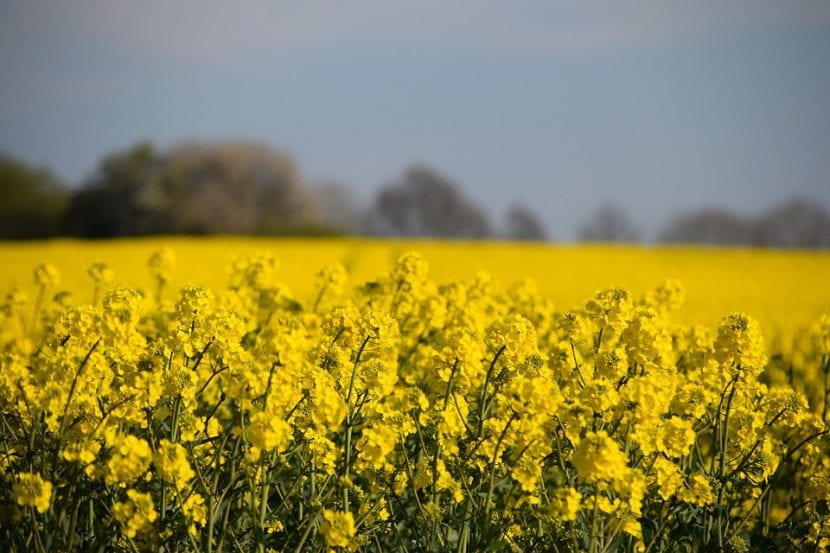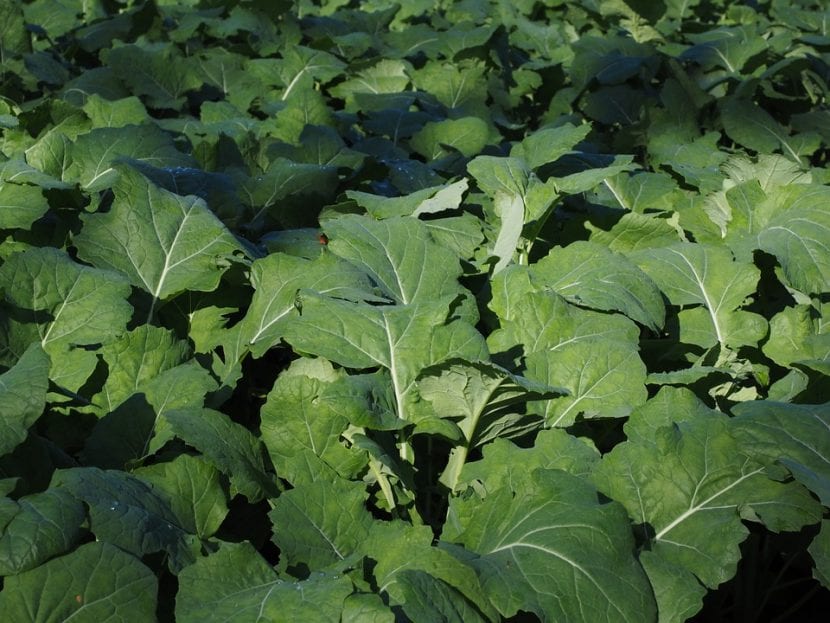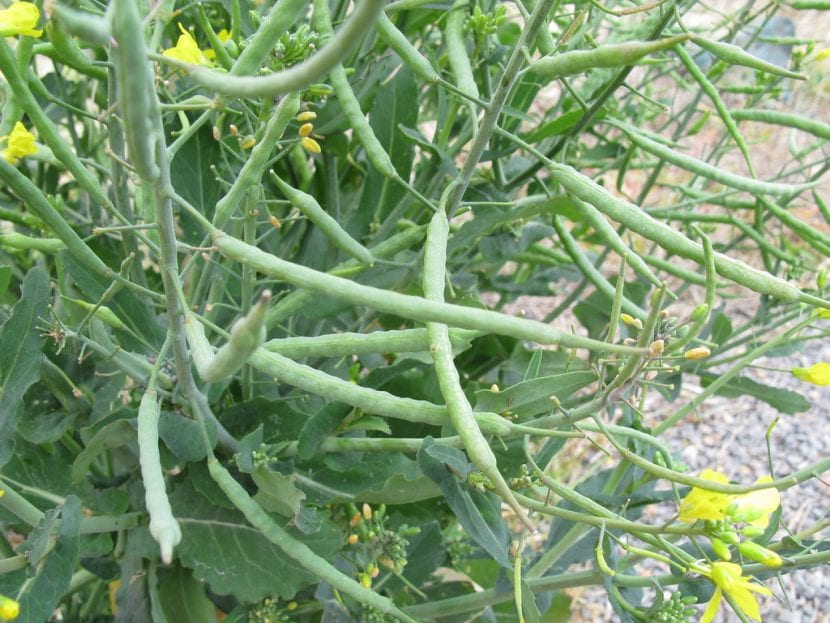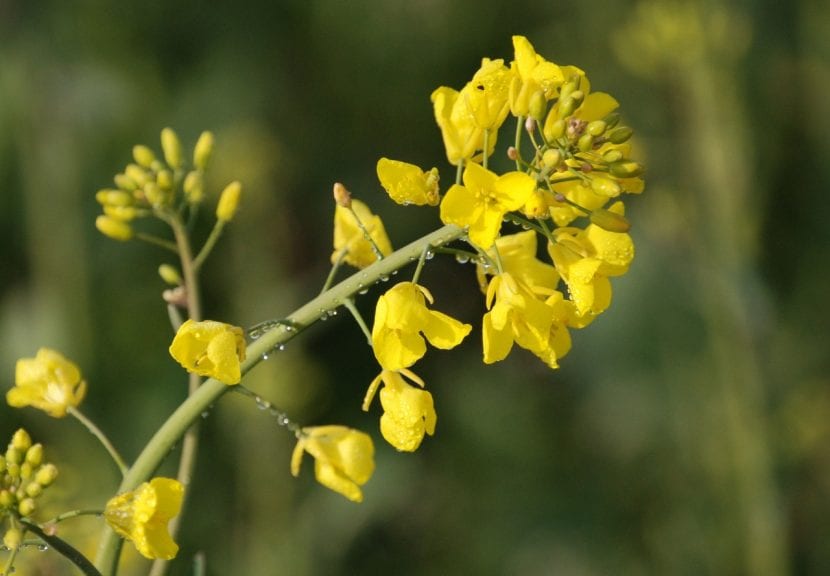
La canola It is one of the herbaceous plants that is most often grown in the world, but it could also be perfectly had in the garden or on the balcony. Have you seen such beautiful flowers? Besides, its cultivation is not complicated at all 😉.
If you want to know why I tell you this, do not hesitate to follow the advice that we offer you next to grow this plant yourself at home.
Origin and characteristics of canola

Our protagonist it is a plant with an annual or biennial cycle native to the temperate regions of the Northern Hemisphere. It reaches a height of up to 150 centimeters, with highly branched stems, especially from the upper part. The leaves measure up to 40cm, and are glaucous, glabrous or ciliated in the veins, petiolate and oblong-lanceolate.
The flowers are grouped in clusters, in number from 20 to 60. The fruits are very numerous, so much so that the plant produces 60 to 100 units, and small ones of 2,5-4mm. The seeds are spherical, brown and 1,2 to 1,8mm in diameter.
Popularly it receives the names of ajenabe, ajenabo, kohlrabi, rapeseed, common turnip, napo, radish, or ñabo.
What are the care it requires?
If you dare to grow canola in your garden, patio or terrace, we recommend providing the following care:
Location
It is a plant that has to be abroadIf possible in an area where direct sunlight gives it the more hours the better (minimum 4 hours, although the ideal would be 6 or more).
Earth
- Flower pot: put a first layer of clay (on sale here) and then finish filling with universal substrate (for sale here).
- Garden: it is not demanding, but if you have a very compact soil, make a hole of about 40 x 40cm, and fill it with a mixture of universal substrate with 30% perlite (on sale here).
Irrigation
Irrigation must be moderate. Depending on the climate, it should be watered an average of 3 to 5 times a week during the summer, and every 3-4 days the rest of the year.
When you water, don't wet the leaves, just the soil. In this way you will prevent them from burning and / or rotting.
Subscriber
It is important fertilize throughout the warm season with organic fertilizers, be they liquid, powder or granulated. The former are especially suitable for plants that are in pots, while the others are better for those that are grown in the ground.
But regardless of which one you use, follow the instructions for use that are specified on the package, especially if you opt for guano or any other fertilizer from birds (marine or poultry) since if you exceed the dose the roots will they would burn fast.
Multiplication

Image - Flickr / Macleay Grass Man
Canola multiplies by seeds, usually in spring but it can also be done in autumn if the weather is mild. The step by step to follow is as follows:
- First, fill a seedling tray (for sale here) with specific substrate for seedbeds (for sale here), and waters.
- Then, plant a maximum of two seeds in each socket, and cover them with a thin layer of substrate.
- Then water again, this time with a sprayer.
- Finally, place the seedbed outside, in full sun.
Keeping the substrate moist will germinate in about 14 days.
Planting or transplanting time
En spring. If you have it in a pot, transplant it to a larger one when you see the roots come out through the drainage holes, or you notice that it has stopped growing.
Plagues and diseases
It is sensitive to aphids, which are small parasites of less than 0,5cm, green, brown or black. They feed on the cells of young leaves and flower buds, but can be fought well with diatomaceous earth (on sale here) or with any insecticide against aphids (like this one that they sell here).
Rusticity
Resists cold and frost up to -7ºC.
What uses is given to canola?

Ornamental
It is a plant that produces beautiful flowers, of a very showy yellow color. When many are planted together, the effect is spectacular. It can be kept in a pot, a planter, or on the ground; on the balcony, terrace, patio or in the garden.
Its care is simple, so I am convinced that you are going to enjoy it a lot.
Culinary
It is the most widespread use. It is planted a lot to produce forage, biodiesel and also vegetable oil for human consumption that is obtained from the seeds. This oil, called rapeseed oil, if natural, is moderately toxic in high doses, but in adequate doses it is a good laxative and can be used in case of arthritis.
Besides, it is also interesting to know that the process of obtaining rapeseed oil leaves as a residue a feed that is rich in protein, which is given to cattle above all, but also to chickens and pigs.
What did you think of the canola?